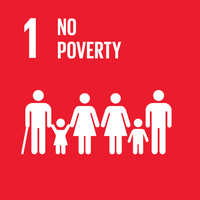SDG 1 No Poverty

No Poverty is the 1st of 17 Sustainable Development Goals set by the United Nations. The No Poverty Goal aims to end all forms of poverty by 2030[2] through increasing access to basic services and resources, implementing programmes and policies, focusing on vulnerable populations, and helping communities struck by disasters caused by conflicts or extreme climate events.[3]
Climate change and energy play significant roles in the efforts to reduce poverty. Increasing climate change is impeding efforts to reduce poverty, and could push 100 million people in vulnerable populations into poverty by 2030. The impacts of climate change, including increasing temperatures, forest fires, droughts, floods, and more frequent and intense natural disasters and extreme weather events[4] can hurt the well-being and health of populations, destroy property, shelters, and sources of income, food, and water. Climate change impacts increase the difficulty of growing food, leading to lower food production, leaving more people hungry.[5]
Access to energy and sustainable energy connections can reduce poverty by creating more jobs, increasing food security, boosting businesses, agriculture, and industry, and saving time for those who need to collect fuel sources currently. In parts of the world with limited energy access, women in particular spend a lot of time gathering biomass fuel and cooking and this time and amount of air pollution can be reduced by implementing good energy connections.[6] Increasing the vulnerable population's access to energy will reduce poverty and improve their quality of life.
Below is an animation from Gapminder displaying the number of people by income over time, from 1800 to 2015. Pink represents Asia and Australia, green represents North and South America, and yellow represents Europe.[7]
For further reading
Next SDG: SDG 2 Zero Hunger
Previous SDG: SDG 17 Partnerships for the Goals
SDG main page: Sustainable Development Goals
List of Targets: Goal 1 Targets
SDG 3 Good Health and Well-Being
SDG 6 Clean Water and Sanitation
SDG 7 Affordable and Clean Energy
SDG 8 Decent Work and Economic Growth
The United Nations Development Programme website on No Poverty
References
- ↑ Wikimedia Commons [Online], Available: https://commons.wikimedia.org/wiki/File:Sustainable_Development_Goal_1.png
- ↑ United Nations Development Programme, "Goal 1: No Poverty,"United Nations Development Programme.[Online]. Available: http://www.undp.org/content/undp/en/home/sustainable-development-goals/goal-1-no-poverty.html. [Accessed March 16, 2018]
- ↑ United Nations Development Programme, "Goal 1 Targets,"United Nations Development Programme.[Online]. Available: http://www.undp.org/content/undp/en/home/sustainable-development-goals/goal-1-no-poverty/targets/. [Accessed March 16, 2018]
- ↑ NASA, "The Consequences of Climate Change," Global Climate Change May 8, 2018. [Online]. Available: https://climate.nasa.gov/effects/. [Accessed: May 11, 2018].
- ↑ The World Bank, "Climate Change," The World bank, April 6, 2018. [Online]. Available: http://www.worldbank.org/en/topic/climatechange/overview. [Accessed: May 11, 2018].
- ↑ International Energy Agency, "Energy Access Outlook 2017," International Energy Agency, Oct. 19, 2017. [Online]. Available: https://www.iea.org/access2017/. [Accessed: May 11, 2018].
- ↑ Gapminder, "Number of People by Income," Gapminder. [Online]. Available: https://www.gapminder.org/tools/#_state_time_value=2015;;&data_/_lastModified:1526067676336&lastModified:1526067676336;&chart-type=mountain. [Accessed: May 11, 2018].

